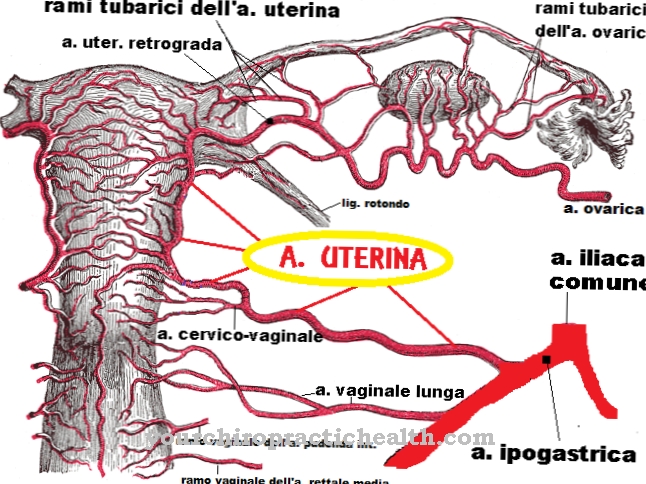The Langhans giant cells are immune cells from fused macrophages and form a typical component of inflammatory granulomas.
Their exact function for the immune system has not yet been fully clarified. They have been observed in the context of infections such as leprosy and chronic inflammations such as Crohn's disease or sarcoid.
What are Langhans giant cells?
Macrophages are the phagocytes of the immune system. These are mobile and mononuclear cells of the cellular defense system. They arise in the serum from circulating peripheral monocytes that migrate into tissue and can spend several weeks there as tissue macrophages.
Macrophages can fuse into so-called Langhans giant cells in the course of a granulomatous inflammatory immune reaction. This immunological cell type is named after Theodor Langhans and thus after the director of the Pathological Institute at the University of Bern. In the 19th century, he coined the term giant cell and used it to describe greatly enlarged cells with several cell nuclei. Although they were discovered more than a century ago and structurally well documented to this day, the exact function of Langhans giant cells in the context of the immune defense has still not been conclusively researched.
Other cells from the group of giant cells are the Sternberg giant cells, the foreign body giant cells and the osteoclasts or megakaryocytes. The so-called epithelial cells are similarly specialized macrophages. Langhans giant cells are among the inflammatory infiltrates to which the neutrophils also belong.
Anatomy & structure
The Langhans giant cells, like all other giant cells, have several cell nuclei and, with a diameter of around 0.3 millimeters, are greatly enlarged cells. Foreign body giant cells arise through macrophage fusion in the course of foreign body phagocytosis.
The Langhans giant cells can be anatomically differentiated from them due to the marginal, horseshoe-shaped sequence to which their individual cell nuclei in the cytoplasmic tissue are subject. Some Langhans giant cells are equipped with Schaumann bodies and asteroid bodies. The Schaumann bodies are round-oval inclusions made of proteins and calcium that carry a lamellar layer. Asteroid bodies, on the other hand, have star-shaped inclusions.
Langhans giant cells are a characteristic part of the granuloma. This is the nodular formation of new tissue that forms in response to chronic inflammatory stimuli or allergies. In addition to giant cells and endothelial cells, they also contain epithelial cells and mononuclear inflammatory cells such as lymphocytes or simple macrophages.
Function & tasks
The fusion of macrophages to form Langhans giant cells has so far mainly been observed in the context of granulomatous diseases. Such diseases can have various causes. The giant cells were detectable, for example, in infectious diseases such as leprosy, tuberculosis and schistosomiasis. Langhans giant cells have also been detected as an inflammatory infiltration of the chronic inflammatory processes in the context of Crohn's disease, sarcoidosis and rheumatoid arthritis.
The specific task of the Langhans giant cells has not yet been scientifically clarified. Presumably they play a role in the phagocytosis of specific antigens and can therefore be assigned to the phagocytes. Phagocytosis is the uptake of extracellular solid particles and corresponds to a sub-form of endocytosis. Phagocytes flow around foreign bodies in order to absorb them through invagination and constriction processes on the cell membrane. This creates large vesicles, called phagosomes, which confluence with lysosomes. Thanks to the lyosomal enzymes, the phagosomes form phagolysosomes.
The enzymatic breakdown of absorbed antigens then begins within the phagolysosome. There was speculation about the phagocytosis of Langhans giant cells, especially in the context of tuberculosis. In this disease, for example, they presumably ingest the tuberculous Mycobacterium tuberculosis and render it harmless. Since this phenomenon could only be observed to a low degree, the cells are primarily associated with the secretion of lysosomal enzymes. Only their specialization in granulomatous inflammation and thus their immunological activity is certain.
You can find your medication here
➔ Medicines to strengthen the defense and immune systemDiseases
The Langhans giant cells are a component of many granulomatous diseases of a chronic and acute nature. In the past, the enlarged cells from fused macrophages were also associated with diseases such as myositis, in addition to those mentioned above.
It is an inflammatory disease of the skeletal muscles. Myositides are usually noticeable as a progressive loss of strength and weakness in predominantly the muscles near the trunk. Difficulty swallowing or muscle pain and wasting are also common symptoms. Sometimes calcium salts build up and cause metaplasia in the affected muscles. The result is muscle ossification. Autoimmune processes are under discussion as causes of myositides. Often this group of diseases is also associated with other primary diseases, which can be viral, bacterial or parasitic in nature. Leprosy and tuberculosis, for example, are associated with the primary viral diseases.
Since the Langhans giant cells were mainly observed in connection with these two diseases, they also play a role in myositides such as tuberculotic myositis. Clinically, this form of myositis manifests itself as swelling of the soft tissues. The tissue becomes necrotic and is populated by giant Langhans cells. However, this form of myositis is extremely rare in Europe. Typical granulomas can again be observed in lymph node tuberculosis. This disease shows a central necrosis with epithelial cells and the Langhans giant cells in circumference. Acid-fast rods are often found in the necrotic tissue.
In patients with poor immune defense, however, the disease usually proceeds without granuloma formation. In countries like Asia, unlike in Europe, the diseases mentioned are an everyday phenomenon. Granulomatous reactions also occur with syphilis, toxoplasmosis, fungal infections and parasite infections. Granulomas have also been observed in carcinomas.
























.jpg)



